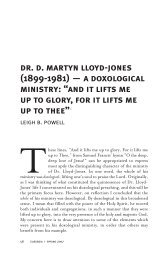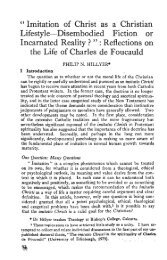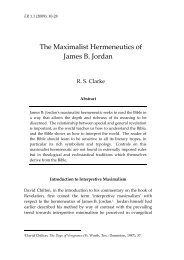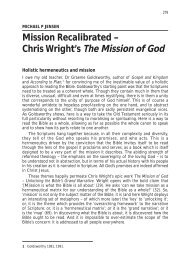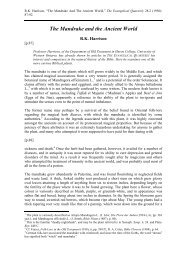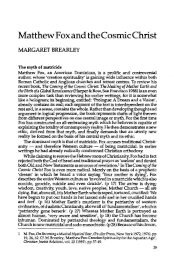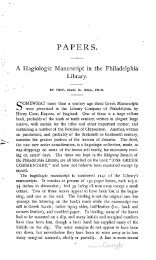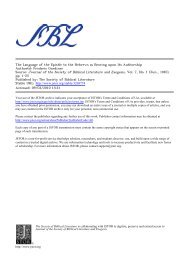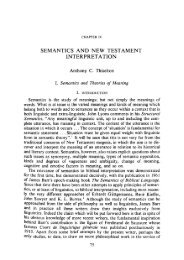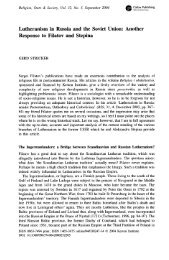Ancient Orient and Old Testament - BiblicalStudies.org.uk
Ancient Orient and Old Testament - BiblicalStudies.org.uk
Ancient Orient and Old Testament - BiblicalStudies.org.uk
Create successful ePaper yourself
Turn your PDF publications into a flip-book with our unique Google optimized e-Paper software.
K.A. Kitchen, <strong>Ancient</strong> <strong>Orient</strong> <strong>and</strong> <strong>Old</strong> <strong>Testament</strong>. London: Inter-Varsity Press, 1966. Hbk. pp.191.<br />
The main destruction of Canaanite Hazor (enclosure level Ia) would fall into the same period. 41<br />
Rowton’s attempt 42 to equate this fall of Canaanite Hazor (stratum XIII of the Tell; enclosure level Ia)<br />
with the campaign of Deborah <strong>and</strong> Barak in judges 4 to 5 instead of that by Joshua in Joshua I I (so<br />
pushing the Exodus <strong>and</strong> initial conquest back into the fourteenth or early thirteenth century BC) flies<br />
in the face of all other collateral evidence, <strong>and</strong> glosses over certain hints in Joshua I I <strong>and</strong> judges 4. It<br />
should be noted that in Joshua I I all the emphasis is on Jabin I as king of Hazor, <strong>and</strong> on Hazor as<br />
‘formerly head of all those kingdoms’, <strong>and</strong> it alone was burnt (Jos. 11:10, 13). It is therefore natural<br />
to associate this with the main end of Canaanite Hazor <strong>and</strong> its burnt remains. But in judges 4, Jabin II<br />
is more often called king of Canaan (Jdg. 4:2, 23, 24 twice) than king of Hazor (Jdg. 4:2, 17), <strong>and</strong><br />
[p.68]<br />
his main strength is curiously not in Hazor but with Sisera in Harosheth. No emphasis<br />
whatever is placed on the city Hazor. This could simply mean that the later Jabin had a small<br />
fortified residence somewhere on (or near) Tell el-Qedah that has not yet been touched by the<br />
excavators, or else merely that he still ruled the state of Hazor but from a different town in<br />
the area. 43 (Only a small proportion of the Tell has been dug down to Canaanite levels; the<br />
examples of Gibeon <strong>and</strong> Arad should be a warning against too hasty an assumption that a<br />
further (but secondary) Canaanite occupation by Jabin II (or a residence nearby) is to be<br />
excluded. 44 ) The occurrence of two kings Jabin is, of course, no more of a doublet than two<br />
Niqmads (II <strong>and</strong> III) <strong>and</strong> two Ammistamrus (I <strong>and</strong> II) in Ugarit, two Suppiluliumas (I <strong>and</strong> II)<br />
<strong>and</strong> two Mursils (II <strong>and</strong> III) of the Hittites, <strong>and</strong> two Amenophis (III <strong>and</strong> IV), two Sethos (I<br />
<strong>and</strong> II) <strong>and</strong> two Ramesses (I <strong>and</strong> II) in Egypt - all in the fourteenth/thirteenth centuries BC.<br />
Furthermore, the type of occupation found on several of these destroyed Canaanite sites is of<br />
a quite different <strong>and</strong> simpler kind, best explained as that of the occupying Israelites. 45 The<br />
biblical account cannot, therefore, be reduced to a peaceful, marginal infiltration by the<br />
Hebrews as required by Noth’s<br />
[p.69]<br />
41 Y. Yadin, BA 22 (1959), pp. 1-20, esp. 4-6, 13-15.<br />
42 M . B. Rowton, CAH 2 , 1:6 (Chronology), 1962, pp. 67-69; cf. F. H. Stubbings, ibid., pp. 75-76, on difficulties<br />
of dating Mycenaean III pottery.<br />
43 E.g., in Gn. 20:1, Abraham dwells between Kadesh <strong>and</strong> Shur, <strong>and</strong> sojourns ‘in Gerar’ - obviously, in the<br />
territory so named, not the walled city itself (probably Tell Abu Hureirah, Albright, BASOR 163 (1961), pp.<br />
47 - 48 n. 59). City <strong>and</strong> state often have the same name in the <strong>Ancient</strong> <strong>Orient</strong>, although distinct entities. This<br />
applied to Carchemish in Hittite politics, for example, where city <strong>and</strong> l<strong>and</strong> (same name) had distinct roles (cf.<br />
H. Klengel, Geschichte Syriens in? s.,7ahrtausend v.u.Z., I, 1965, pp. 41, 48 n. 54). Assur-uballit II, last king<br />
of ‘Assyria’, reigned in the West at Harran (outside his home territory) when Babylonians <strong>and</strong> Medes had<br />
destroyed the ancient capitals of Assyria proper, occupying the l<strong>and</strong> (cf. D. J. Wiseman, Chronicles of<br />
Chaldaean Kings, 1956, pp. 17-19, 45, 61-63).<br />
44 J. Gray, VT 16 (1966), 26-52, compactly surveys the history <strong>and</strong> archaeology of Hazor (not using Hazor<br />
III-IV), but his treatment of the conquest marks no advance, while his sceptical view of Joshua’s role rests on<br />
no tangible, objective basis.<br />
45 On this matter see G. E. Wright, JBL 60 (1941), pp. 27-42, esp. 30-33; Biblical Archaeology, 1957, pp. 81,<br />
<strong>and</strong> esp. 88-89; Albright, op. cit. in note 37, p. 66, above.




